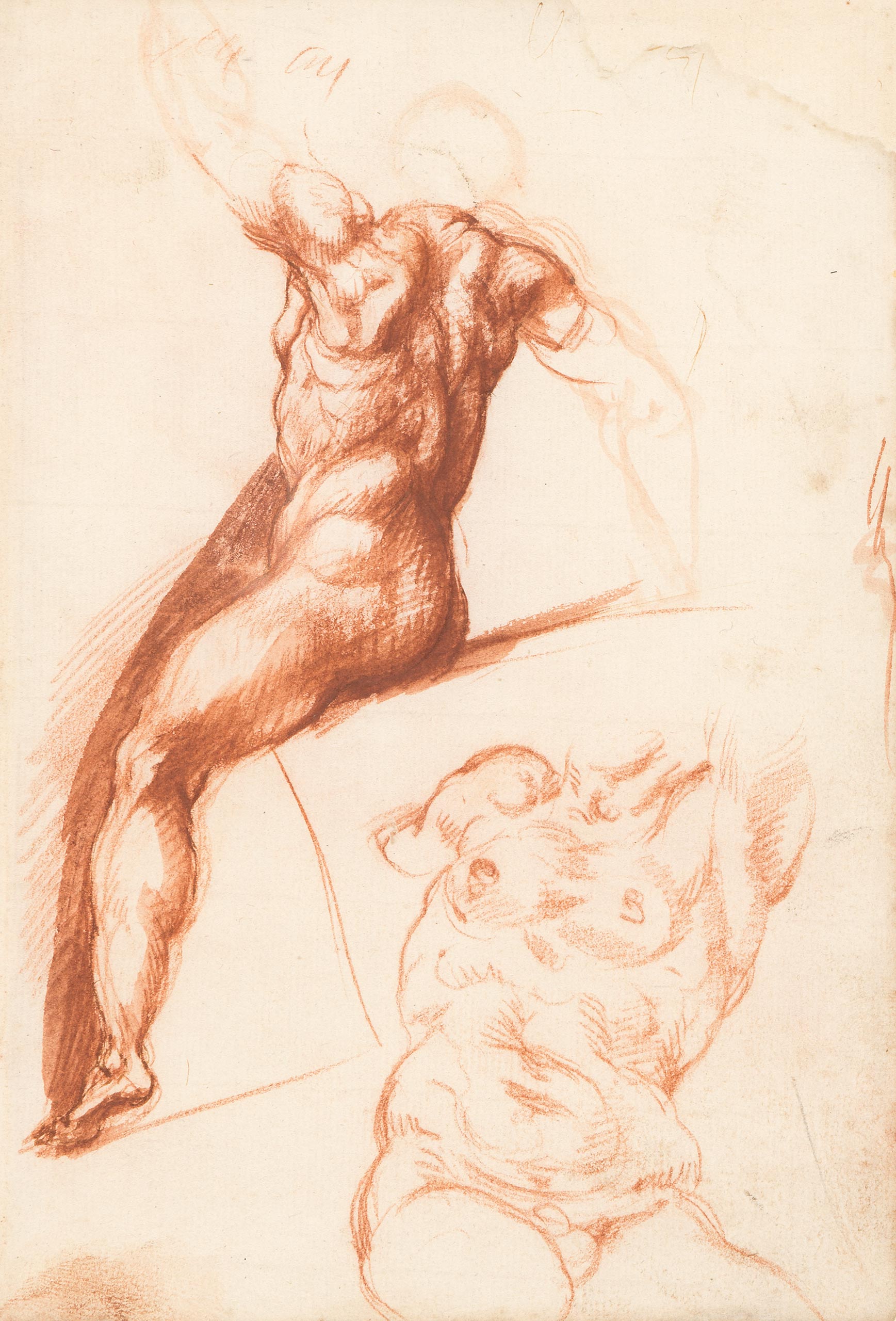
Alberti
Cherubino
Borgo San Sepolcro 1533 – Rome 1615
Study of a Seated Male Figure with a Subsidairy Study of a Male Torso
Red chalk, red wash.
200 x 135 mm (7 7⁄8 x 5 5⁄16 in.)
Sotheby’s London, December 7, 1976, lot 31: a sketchbook of 26 pages, with preparatory drawings for the decoration of the Sala Clementina; private collection.
The sons of the sculptor and carver Alberto di Giovanni, Cherubino Alberti and his brother Giovanni were first trained by their father who worked for the Medici in Florence. Alberto di Giovanni’s good relations with such important artists as Giorgio Vasari were probably crucial to the career of his sons, who accompanied him when he moved to Rome in 1564 to work for cardinale Ugo Boncompagni (the future Pope Gregory XIII) ; his diary1 gives a detailed description of his artistic activities in Rome between 1572 and 1576. There, his sons discovered ancient remains, which they copied extensively. It was also there that Cherubino learnt engraving, from Cornelis Cort according to some sources. He developed an intense activity as an engraver until the end of the 1580s, working after the brothers Taddeo and Federico Zuccaro, as well as Andrea del Sarto, Polidoro da Caravaggio, Rosso Fiorentino, Marci Pino, Pellegrino Tibaldi and others. The corpus of his engraved works contains 189 plates.
From the 1580s onwards, Cherubino devoted himself more to painting, and one of his first documented works is the painted decoration of the rear façade of the Vatican Library in 1587 (no longer preserved). He worked mainly in Rome, where he became one of Clement VIII’s official painters. He received commissions for painted decorations, the best known being those for the Sala Clementina in the Vatican Palace, painted between 1596 and 1598 in collaboration with his brother Giovanni and, according to some sources, Baldassare Croce: in the centre, in the fake opening of the illusionist ceiling, Saint Clement is depicted in glory, surrounded by numerous virtues
and large cartouches containing the papal coat of arms. In Rome, Cherubino also painted decorations such as those for the vault of the Aldobrandini chapel in Santa Maria sopra Minerva in 1606, the sacristy of San Giovanni in Laterano, the main chapel of San Silvestro in the Quirinale and the churches of Santa Maria del Portico and Santa Maria in Via Lata, all works that bear witness to his attachment to the aesthetic principles of late Mannerism. In 1611, he was made a principe of the Academy of Saint Luke.
In addition to his Roman career, he worked in Perugia (1587), Florence (1589) and Naples (1593). In his home town of Borgo Sansepolcro, he painted facades that have now disappeared, as well as frescoes such as those on the life of Christ for the oratory of the Crocifisso company. He died on 28 October 1615 in Rome, where he was buried in Santa Maria del Popolo.
A prolific draughtsman, Cherubino left numerous sheets, copies of studies after the masters or preparatory studies for his reproduction prints, as well as drawings of his own invention. Imbued with the graphic art of the Zuccari and the great masters of the early 16th century, Alberti’s sheets are distinguished by their ease of line, fluidity of pen and wash, and graceful, virtuoso use of red chalk. The Istituto Nazionale per la Grafica in Rome holds an album containing numerous drawings by Cherubino and Giovanni, whose hands are not always easy to distinguish. In our sheet, the Michelangelesque anatomy seems fairly characteristic of Cherubino. The sheet comes from an album sold at public auction in 1976, which contained numerous studies related to the Sala Clementina. These studies may therefore have been early thoughts and tests for the ignudi of the decor.
- Dijon, musée des Beaux-arts, Inv. 1994.4.1. See Marguerite Guillaume,
« Un « journal » retrouvé : Alberto Alberti », Bulletin des musées de Dijon, n° 1, 1995, p. 17-32.

